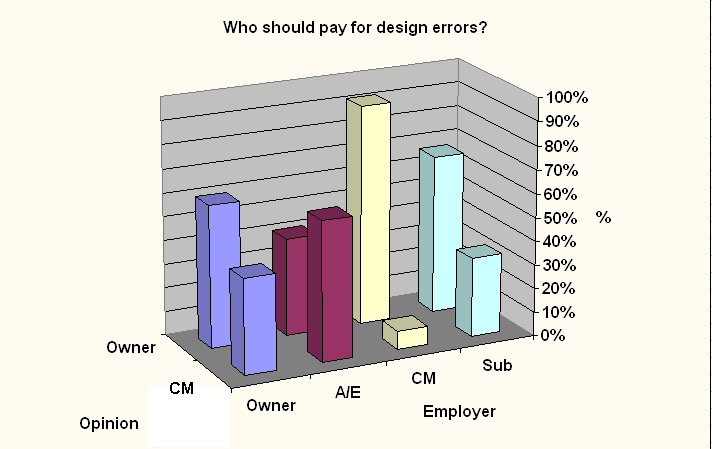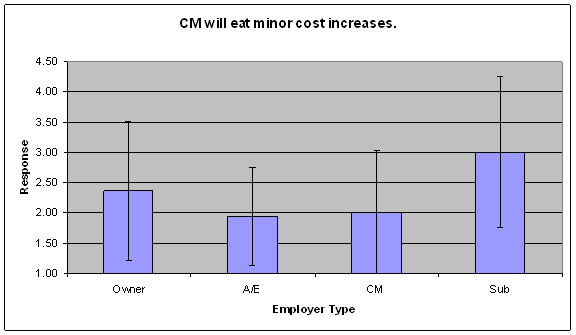
Who Should Pay for Design Errors?
There was little agreement between the parties on who should pay for design errors and the parities' tolerance for small cost increases.
Summary
The majority of Owners felt they should pay for design errors, while A/Es felt the opposite. CMs, Owners, and A/Es all felt CMs would absorb small cost increases due to design errors, while Subs did not feel that was true. There was a wide variation in Subs willingness to absorb small cost increases due to design errors.
Report
Of course on any job of complexity, there will be design errors. In another section we found that there are errors in CMAR, although perhaps not as many as DBB. In DBB it is clear that the Owner must pay the contractor for rectifying design errors. Besides the direct cost of the error, the contractor will want to be compensated for the disruption to his work. In CMAR, however, the responsibility is not as clear, since the CM and often the Subs reviewed the design. In addition, since the CM organized and scheduled the work, costs of disruption should be less, also, since the CM is involved in the design, they are aware of the design intent which should make early detection of error more likely. If the cost is small, the CM should have money in his contingency to cover it. But the CM wants to hoard his contingency for cost increases not related to design errors and feels that the Owner should cover this from the Owner’s contingency. So we asked, “If the costs of a design error were taken from the contractor’s contingency under the GMP, it could cost the CM if they were receiving a percentage of cost savings and/or it will reduce the CM’s contingency that might be needed for other risks.
Which do you think is fair?
___ Take it out of the owner’s contingency, since the error is not the CM’s.
___ Take it out of the contractor’s contingency, since the CM reviewed the design and is in the best position to control the cost increase.”

Here the result was surprising. A full 60% of the Owners felt that they should pay and only 40% felt the CM should pay. The A/Es, was reversed, 60 saying that the CM should pay. The CM is not surprising, almost all felt the Owner should pay, but 33% of the Subs felt the CM should pay. There was no trend based on CMAR experience.
Note the Owner and the A/E reversed. That is not unexpected. There is always a chance that the Owner will ask the A/E to pay for a change order necessitated by a design error. By ascribing to the CM some responsibility for reviewing the design, the A/E may feel their liability is reduced. This is likely to be true for a patent error, but would be a stretch for an error that would require calculations to discover.
An important point is when in the construction process the design error is rectified. If it is towards the end of the project and the CM still has money in his contingency, he might as well pay for changes, since he will have to give the remaining money back to the Owner. The question mentions the situation where the CM shares the left over contingency, but such arraignments are rare in public CMAR.
“In general, do you feel the CM will “eat” minor cost increases due to design, or third party coordination issues that total less than 1% of cost and may decrease the CM’s contingency slightly, in order to, improve his chances of future work with the owner or recommendations to other owners? Score 1-5, where 1 means strongly agree and 5 means strongly disagree.”

The CMs, the party that presumably knows the answer, agreed with the statement. The Owners agreed, but not as much, the A/Es agreed slightly more. The Subs were neutral, note the wide variance for the Subs.
The Owner, CM, and A/E all believe that the CM will accept minor cost in order to be cooperative. The Subs agree with less with this. This may be due to the nature of the typical CMAR contract for the CMs, who are really not loosing money, but rather loosing part of their contingency. Unless they have a contract that specifies sharing of the unspent money, the CM does not pocket any of the contingency when the job is done. On the other hand, most Subs have a fixed price contract and any extra expenses they do not get reimbursed for comes out of their pocket. Presumably the Subs understand the CMs fee arrangement.
Another possibility is that the Subs interpreted the 1% hit by the CMs as being a cost that the CM could try to pass along to the Subs. So we asked, “In general, do you feel the subs will “eat” minor cost increases due to design errors, that total less than 1% of their contracts, which decrease their fee slightly in order to improve there chances of future work with the owner or CM? Score 1-5, where 1 means strongly agree and 5 means strongly disagree.”
There was no trend based on CMAR experience. There was no trend based on employer. The average answer of 2.85 would indicate neutral. Subs averaged 3.0 which would indicate neutral, neither agreeing nor disagreement with the statement. There was a wide SD, however, which indicates Subs had strong opinions, but they were mixed. Here are the individual responses.
Individual Responses of Subs |
|
Score |
Number of Responses |
1 (Strong Agreement) |
3 |
2 |
2 |
3 |
2 |
4 |
2 |
5 (Strong Disagreement) |
3 |
Clearly, some Subs felt they would eat a minor cost increase and some were sure they would not.
Observations
A commenter summed it up, “ The CM is expected, because a GMP is prepared prior to completion of the documents, to be carrying some contingency to fill in the “blank spaces” in the design and then they remain participants in the process of completing the design and documents. More is known throughout the process so there are simply fewer reasons to look for financial help to cover the unknowns. The Owner will be sufficiently involved to truly understand the implications of late changes and shortened schedules throughout the process. And the Owner will need to carry a reasonable contingency, which will vary depending on how early the GMP is set.”
So, the amount of contingency, both the CMs and the Owners, will depend on the stage of design completion when GMP is set. If there is a large contingency, it was likely because the design was incomplete, hence the CM would have little cause to ask for more money. On the other hand, Subs are more likely than CMs to propose on a completed design and hence have less contingency in their bid or proposal and be less likely to absorb small cost increases. The wide variation in the Subs responses may be due to the timing of their price/proposal that they are accustomed to.
Although the survey results indicate some disagreement, note there would be no disagreement, if similar questions were asked about DBB. So these disagreements indicate likely points of tension that need to be monitored, but considering its about money, the disagreements do not seem mild.